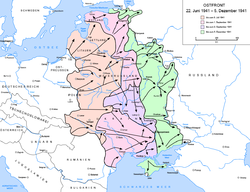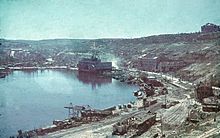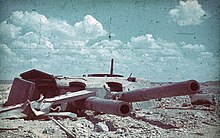Battle of Sevastopol 1941–1942
| date | October 30, 1941 to July 4, 1942 |
|---|---|
| place | Sevastopol , Crimea , Soviet Union |
| output | Axis victory |
| Parties to the conflict | |
|---|---|
| Commander | |
| Troop strength | |
| ~ 200,000 soldiers | ~ 140,000 soldiers, including ~ 15,000 soldiers |
| losses | |
|
~ 27,000 men on the German side, of which ~ 4,300 dead |
~ 115,000, including ~ 97,000 prisoners |
The Battle of Sevastopol ( Russian Севастопольская оборона ) was a battle that took place from October 30, 1941 to July 4, 1942 on the German-Soviet front in World War II around the fortified seaport of Sevastopol .
course
prehistory
The German 11th Army under General der Infantry Erich von Manstein reached the Crimean peninsula in autumn 1941 and tried unsuccessfully to take Sevastopol between October 30 and the beginning of November. On November 4, the Sevastopol Defense District was founded under Filipp Sergejewitsch Oktjabrski (1899-1969), commander of the Black Sea Fleet . The Soviet coastal army was commanded by Major General Ivan Petrov . This district comprised around 50,000 men, 170 guns, and 90-100 aircraft. The main forces of the Black Sea Fleet went to ports on the Caucasian coast in early November . About 15,000 residents of the city reported to the Landwehr .
First attacks (November 1941 to May 1942)

On November 11th, four infantry divisions, a motorized division and a Romanian motorized brigade with about 60,000 men began a first offensive on Sevastopol. The main attack was directed towards Balaklava and the auxiliary attack along the Kara Kobja valley. However, they only advanced one to four kilometers and then began the scheduled siege on November 21. The second offensive began on December 17th. Seven German infantry divisions and two Romanian mountain infantry brigades (1275 guns, 150 tanks and up to 300 aircraft) attacked in the direction of the north bay and the auxiliary attack in the direction of Inkerman along the Chernaya River . The district was reinforced by two rifle divisions and a brigade that had been transported across the sea. Supported by ships and aircraft that had arrived, Soviet troops carried out a counterstrike and threw the Axis powers back in the main direction.
Because of the Kerch-Feodosiya operation , a Soviet counter-offensive in eastern Crimea, which began on December 25 , the Wehrmacht withdrew its forces from Sevastopol. When the Red Army counterstrikes in Sevastopol from January to March 1942, the Axis powers were thrown back in some sections. At the end of May 1942, the Kerch peninsula was captured by the Wehrmacht with the bustle hunt , which worsened Sevastopol's situation.
Sturgeon fishing company (June to July 1942)
At the beginning of June 1942, the second large-scale attempt to conquer the Sevastopol fortress was launched under the code name of Störfang . Almost all of the forces of the 11th German Army with 7½ divisions and the Romanian 3rd Army with 1½ divisions were then concentrated around Sevastopol , a total of around 200,000 men. Artillery support was provided by 24 launcher batteries, 81 heavy and 66 light batteries with a total of around 600 guns. The heaviest artillery with a caliber of up to 800 mm was used, including the Dora railway gun and two Karl series mortars . The Luftwaffe joined the VIII. Fliegerkorps under Colonel General Wolfram von Richthofen with seven combat, three Stuka and four fighter groups (about 600 aircraft).
At the beginning of July, after some reinforcements, Soviet troops had a strength of 106,000 men and had 600 artillery pieces and mortars (including the heavily armored coastal battery Maxim Gorki I and coastal battery Maxim Gorki II, each with four 30.5 cm cannons), as well as 38 tanks and 53 aircraft.
From May 27, Sevastopol was bombed non-stop by the air force and artillery. From June 2nd to June 7th, strong artillery and air preparation was carried out. On the morning of June 7th, the attack began on the ground over a front width of 35 kilometers. The main attack was directed towards the east bank of the north bay and the auxiliary attack over the Sapun Heights towards the southeastern outskirts of Sevastopol. The XXX was scheduled for the southern section . Army corps under Artillery General Maximilian Fretter-Pico with the 72nd and 170th Infantry Divisions and the 28th Light Infantry Division between Balaklawa and Komary against the Sapun Heights. In the middle section near Tschorgun the Romanian mountain corps with the Romanian 1st and 18th divisions with attack on Inkerman. In the northern section the LIV. Army corps under General Erik Hansen with the 22nd, 24th, 50th and 132nd Infantry Divisions in the direction of Severnaya Bay. By repelling the German-Romanian attacks in the first five days, the ammunition stocks of the defenders were reduced. In the course of the attack, the 132nd Infantry Division suffered such high losses that it had to be completely taken out of action. Men of the Pioneer Battalion 24 managed to blow up the "Maxim Gorki I" fort and its extensive underground bunkers. On June 17, the 31st Infantry Regiment captured the forts “GPU”, “Molotov” and “Cheka”. Three days later, the northern fort and the Konstantinovsky battery, which were used to control the port facilities, fell. On June 18, the Axis powers reached the North Bay, Inkerman and the Sapun Mountain. Small amounts of ammunition and food were supplied to the defenders by Soviet submarines. On June 29, German troops entered the city and on June 30 also other sections and attacked Malachov-Kurgan. On the evening of June 30th, the Soviet troops withdrew from there. On July 1, the Axis powers blocked the coast from the sea, which was also within range of German artillery, and began to occupy the city. Only a few Red Army soldiers could be evacuated. With the capture of the Chersonese peninsula , the conquest of Crimea ended on July 4, 1942. Colonel-General Erich von Manstein was appointed Field Marshal General on July 1st . The Crimean Shield was donated for members of the Wehrmacht who took part in the fighting in the Crimea in 1941/1942 .
Many German fighters at the front were impressed by the heroism of the Soviet defenders. A contemporary report stated:
“One can only marvel at such an attitude again and again, it is unbelievable in the truest sense of the word. So they have been defending Sevastopol all along the line and so it was a tough nut to crack. The whole country literally had to be plowed up with bombs before they fell back a little ”
The representative of the Foreign Office in the 11th Army Otto von Hentig wrote in a report on July 6, 1942:
“What were the forces that enabled the Russians to perform like this? The soldiers on the front recognize that the achievements were monstrous. How often have I been amazed to hear: 'No French or English would have done that, we couldn't even have endured it!' It could not have been the Politruk's or the commandant's pistol alone that drove the people onward or made them persevere. "
When reports from soldiers at the front about the resistance of the Soviet soldiers also appeared on the radio and in the press, Propaganda Minister Joseph Goebbels forbade any positive emphasis on the Soviet opponent, pointing out that "the resistance of the Bolsheviks is not about heroism and bravery at all," but solely it is about the "primitive animality of Slavism organized by a wild terror to resistance". And he found it "extremely dangerous" that it had been expressed "that the Soviets also had an idea that inspired them to fanaticism and heroic resistance and did not shy away from any privations and efforts in the interests of warfare."
consequences
After the heavy battle, only nine buildings remained undamaged in the city. The Berlin correspondent for the Neue Zürcher Zeitung reported a few days later:
“The city of Sevastopol itself, which is splendidly situated on the roadstead, offers the picture of desolate devastation. It has to be built from scratch. There is [...] no more house that is habitable. The houses are either burned out or [...] just a pile of rubble [...]. "
Red Army prisoners and casualties
More than 10,000 Soviet soldiers were killed in action, and between June 7 and July 4, around 97,000 coastal army soldiers were taken prisoner by Germany .
Combat strengths and losses of the German troops
The following table shows the combat strengths and losses of the German troops during the second large-scale offensive in June 1942: It should be noted that the five divisions mentioned represent only part of the troops deployed.
| division | Combat strength June 1, 1942 | Combat strength July 1, 1942 | Fallen | wounded | Missing | Total losses |
|---|---|---|---|---|---|---|
| 22nd Infantry Division | 13,445 | 9,297 | 670 | 3,251 | 395 | 4,316 |
| 24th Infantry Division | 11,148 | 8,811 | 704 | 3,295 | 136 | 4.135 |
| 50th Infantry Division | unknown | unknown | 488 | 2,784 | 178 | 3,450 |
| 132nd Infantry Division | 9,842 | unknown | 471 | 2,404 | 292 | 3,167 |
| 170th Infantry Division | unknown | unknown | 251 | 1,344 | 98 | 1,693 |
The 33-day battle for Sevastopol had cost the 11th Army 18 percent of its nominal strength, around 35,800 men, in losses, including 5,786 dead or missing. All four infantry divisions of the main fighting LIV. Army corps had suffered losses of at least 30 percent and their infantry battalions were severely decimated. The losses among officers and non-commissioned officers were particularly heavy with over 200 dead and 570 wounded. In Choltitz 's Infantry Regiment No. 16, only 347 men, of an original strength of 3,000 men, were still operational in June 1942.
Overall, the conquest of Crimea from the attack on Perekop to the fall of Sevastopol cost the AOK 11 over 96,000 men, including 21,600 dead and missing about 74,000 wounded. Even if the Romanian army was also killed by around 19,000, the losses of the Axis troops in the Crimea from 1941 to 1942 could be set at around 115,000. The case of Sevastopol was to be assessed positively for the Wehrmacht insofar as the entire AOK 11 was vacated to be deployed on other sections of the front. General of the infantry Franz Mattenklott was appointed as commander in the Crimea, and his General Command 42 was left as the command authority .
Trivia
Lyudmila Pavlitschenko , who is considered the most successful female sniper , also fought on the Soviet side .
Individual evidence
- ↑ Schramm, 1942, Part 2, p. 1343.
- ↑ a b Schramm, 1942, part volume 2, p. 1412.
- ↑ Schramm, 1942, Part 1, p. 397.
- ↑ a b c Schramm, 1942, part volume 2, p. 1414.
- ↑ a b Schramm, 1942, part volume 2, p. 1416.
- ↑ Bernd Wegner : The spring battles 1942 . In: MGFA (Hrsg.): The German Reich and the Second World War . Stuttgart 2001, Volume 7, p. 849.
- ↑ Wegner, Spring Battles, p. 849.
- ^ Ortwin Buchbender : The sounding ore. German propaganda against the Red Army in World War II . Stuttgart 1978, p. 361.
- ↑ Wegner, Spring Battles, p. 849.
- ↑ Willi A. Boelcke : Do you want total war. The secret Goebbels conferences 1939-1943 . Munich 1969, p. 334 ff.
- ^ According to Friedemann Needy : Chronicle of the Second World War, Chronik Verlag, 2004, p. 206.
- ↑ Robert A. Forczyk: Sevastopol 1942: triumph of Manstein's . Osprey, Oxford 2008, ISBN 978-1-84603-221-9 , at p. 90.
literature
- John Erickson: Road to Stalingrad , Cassel Military Paperbacks Edition, London 2003, ISBN 0-304-36541-6 . (English).
- Robert Forczyk : Sevastopol 1942: von Manstein's triumph . Osprey, Oxford 2008, ISBN 978-1-84603-221-9 . (English).
- Franz Kurowski : Sevastopol. The attack on the strongest fortress in the world in 1942 . Podzun-Pallas, Wölfersheim-Berstadt 2002, ISBN 3-7909-0744-8 .
- Erich von Manstein : lost victories . Athenäum-Verlag, Bonn 1955. (Military memories 1939–1944 of the German General von Manstein. Numerous editions, most recently 19th edition in Bernard & Graefe Verlag, Bonn 2011, ISBN 978-3-7637-5253-9 ).
- Percy Schramm (Ed.): War Diary of the OKW , 1942, Part 1 and 2. Weltbild, Augsburg, ISBN 3-8289-0525-0 .
- Hans-Rudolf Neumann (arrangement): Sevastopol / Crimea. - Documents, sources, materials, quotations: A workbook (3 parts) ; S. Roderer Verlag, Regensburg 1998, ISBN 3-89073-220-8 .
- CG Sweeting: Blood and Iron: The German Conquest of Sevastopol . Brassey's, Washington 2004, ISBN 1-57488-796-3 . (English).








